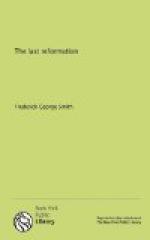[Sidenote: Vision of four beasts]
The four constituent parts of Nebuchadnezzar’s visionary image were interpreted to signify four successive monarchies, the Babylonian being the first. In the seventh chapter Daniel records his own vision of four great beasts that arose out of the violently agitated sea, and these represent the same four kingdoms described in Nebuchadnezzar’s dream. “These great beasts, which are four, are four kings, which shall arise out of the earth” (verse 17). To the worldly, carnal mind of Nebuchadnezzar, empires possessed a show of grandeur and glory, and they were therefore represented accordingly in his vision; but to the spiritual-minded Daniel they would appear odious and terrible, and they were therefore represented to him under the symbol of devouring beasts.
The kingdoms symbolized by the first three beasts of this vision have no particular bearing on our subject, aside from assisting us in fixing the chronology of certain events. The first beast signifies the Babylonian Empire, corresponding to the head of the image in Nebuchadnezzar’s vision; the second, the Medo-Persian, corresponding to the breast and arms of silver; the third, the Grecian, corresponding to the belly and thighs of brass. The description of these beasts shows that in one sense they are successive and in another sense simultaneous.
I have already shown that the entire image of Nebuchadnezzar’s dream was standing in the days of Roman ascendency, when the kingdom of God came. The same fact is brought out in the chapter now under consideration. After mentioning particularly the fourth beast, Daniel says, “As concerning the rest of the beasts, they had their dominion taken away: yet their lives were prolonged for a season and time” (verse 12). When these kingdoms lost their independent sovereignty, they still continued as provinces, ruled by another similar power.
[Sidenote: The fourth beast]
The description of the fourth beast directly concerns our subject: “After this I saw in the night visions, and behold a fourth beast, dreadful and terrible, and strong exceedingly; and it had great iron teeth: it devoured and brake in pieces, and stamped the residue with the feet of it: and it was diverse from all the beasts that were before it; and it had ten horns. I considered the horns, and, behold, there came up among them another little horn, before whom there were three of the first horns plucked up by the roots: and, behold, in this horn were eyes like the eyes of man, and a mouth speaking great things” (verses 7, 8).




